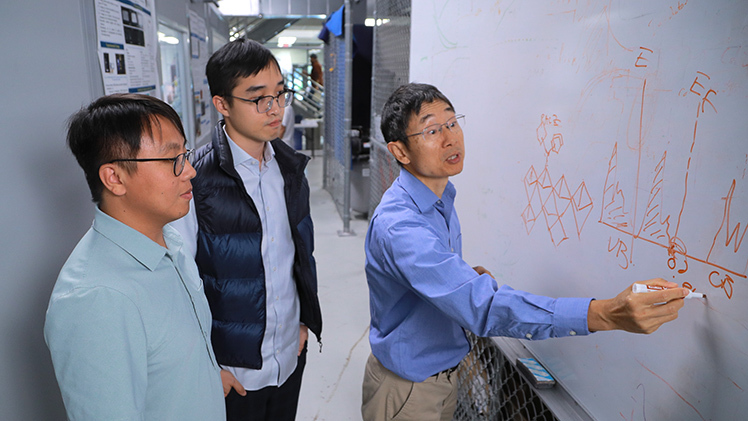In a paper published this month in Nature, “Towards linking lab and field lifetimes of perovskite solar cells,” the researchers addressed methods of testing the real-world longevity of this cutting-edge technology.
Dr. Yanfa Yan, Dr. Xiaoming Wang and Yeming Xian are co-authors on the paper, representing UToledo’s Department of Physics and Astronomy and Wright Center for Photovoltaics Innovation and Commercialization. They join the National Renewable Energy Laboratory (NREL)’s Kai Zhu, Qi Jiang, Robert Tirawat, Ross Kerner, E. Ashley Gaulding, Jimmy Newkirk and Joseph Berry.

From right, Dr. Yanfa Yan, a Distinguished University Professor in the Department of Physics and Astronomy, and his UToledo colleagues, Yeming Xian and Dr. Xiaoming Wang, joined scientists at the National Renewable Energy Laboratory to publish research in Nature to advance perovskite solar cell development.
The Golden, Colorado-based NREL took the lead on the research, while Yan and his UToledo colleagues offered expertise and theoretical calculations at a distance. It’s the latest example of close collaboration between UToledo and one of the U.S. Department of Energy’s 17 national laboratories.
“These relationships give us access to eminent scientists and researchers, as well as the best scientific instrumentation and the fastest supercomputers in the world,” said Frank Calzonetti, vice president for innovation and economic development. “They also position us at the forefront of scientific innovations with real-world impact and allow us to lend our expertise in areas like solar energy and water quality.
“Dr. Yan’s work on perovskite cells is of great interest to the solar energy community, and we’re fortunate to have him at UToledo.”
Perovskite cells are in development as a lower-cost, higher-performance alternative to the industry-standard silicon. They’re constructed with a family of hybrid organic-inorganic materials with a crystalline structure.
Yan, a Distinguished University Professor in the Department of Physics and Astronomy, and his collaborators have previously shared breakthroughs on perovskite solar cell technology in academic journals.
They most recently addressed concerns about the technology’s durability, demonstrating that cells treated with a diphosphine Lewis base molecule retained a high-power conversion efficiency after continuous operation under simulated sun illumination for more than 3,500 hours. That research was published in Science in February.
UToledo researchers had earlier collaborated with the University of Toronto to generate record-setting voltage with an extremely high-efficiency all-perovskite tandem solar cell, in research published in Nature in November. The tandem solar cell’s power-conversion efficiency also broke the record for traditional silicon cells.
In their most recent paper in Nature, Yan and his colleagues establish that laboratory tests can be used to predict how solar cells will function in real-world conditions over six months. These tests suggest an indoor accelerated test can assess a cell’s efficiency after 10, 20 or 30 of outdoor operation.
“You do a few weeks in a laboratory, and you can predict what happens in the field over decades,” Yan said. “While lab-accelerated testing is standard practice, this is the first time we’ve shown for this particular technology that it’s possible to link the laboratory test lifetime and the field test lifetime.”
Researchers found that perovskite cells should be subjected to a combination of simultaneous stress tests to predict how they will function outdoors, with high temperatures and illumination the most critical combination of stressors.
“We don’t know yet know how long a perovskite solar panel will last in the field, so this research provides very useful information for the commercialization of the technology,” Yan said.
Yan, who is collaborating on other perovskite cell-related research with the Lawrence Livermore National Laboratory in California, already had a relationship with the NREL when he arrived at UToledo in 2011. He’d worked there for more than a decade.
UToledo traces most of its other collaborations with national labs to 2019, when it hosted National Lab Day in partnership with U.S. Rep. Marcy Kaptur and Mike Witherell, Toledo native and chief of the Lawrence Berkeley National Laboratory in California. Directors of 10 national laboratories and the U.S. Department of Energy’s Office of Science, among other leading scientists and engineers from the labs, traveled to campus to discuss ways to connect and collaborate between the University and the national labs, leveraging each other’s assets and expertise.
UToledo researchers later traveled to several national labs to establish working relationships.
“We have very strong relations with the National Renewable Energy Laboratory. We have very strong relations with the Lawrence Livermore National Laboratory, the Idaho National Laboratory, Oak Ridge National Laboratory, the Lawrence Berkeley National Laboratory and the Argonne National Laboratory,” Calzonetti said. “We’re working with the Pacific Northwest National Laboratory in Washington on COMPASS, which is investigating coastal systems and their response to short- and long-term changes.”
Other current research collaborations with national labs address harmful algal blooms, the efficiency and longevity of lead batteries and the production of clean hydrogen as a fuel alternative, among numerous other topics.
A delegation from Argonne National Laboratory will be on campus to discuss neuroscience research collaboration on Tuesday, Oct. 10.
UToledo, which has been a leader in solar energy research for more than three decades, joins the NREL as a founding member of the U.S. Manufacturing of Advanced Perovskites Consortium, established in 2020, and the U.S. Manufacturing of Advanced Cadmium Telluride Consortium, established in 2021. It also leads the U.S. Department of Energy’s Cadmium Telluride Accelerator Consortium, launched in 2022 and administered by the NREL. Cadmium telluride solar cells are another promising alternative to silicon.